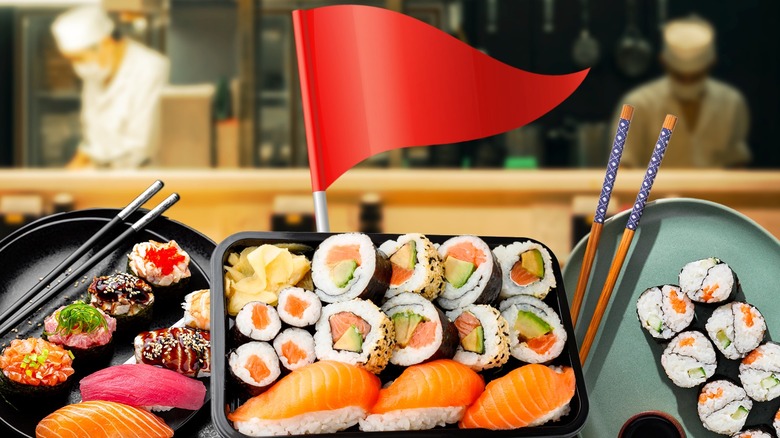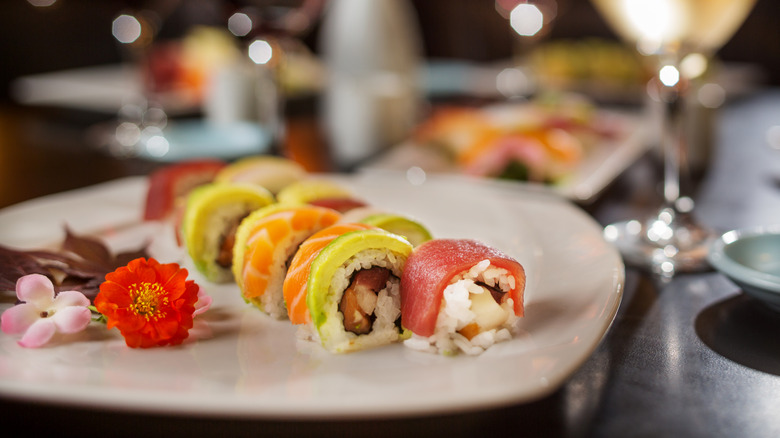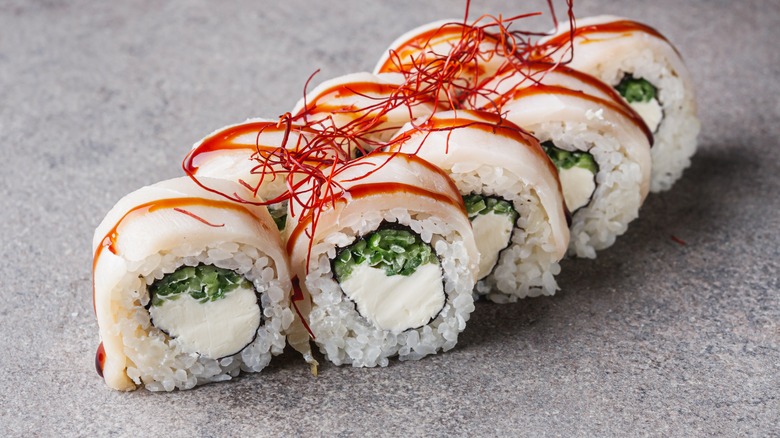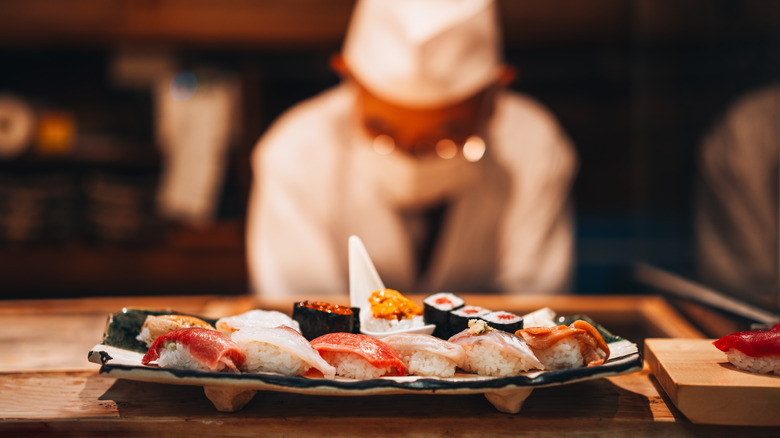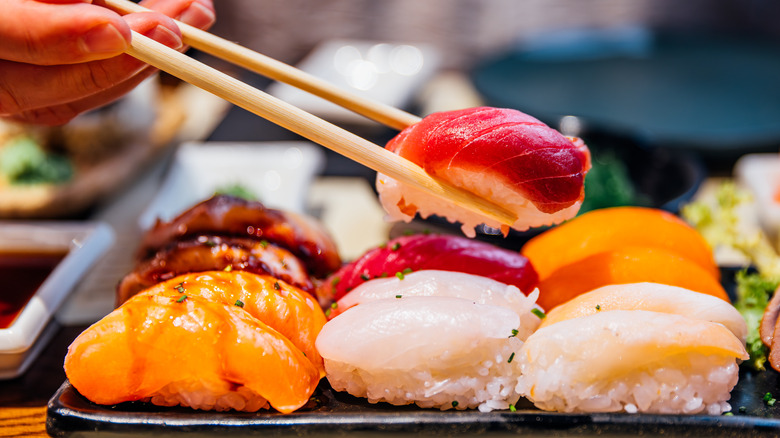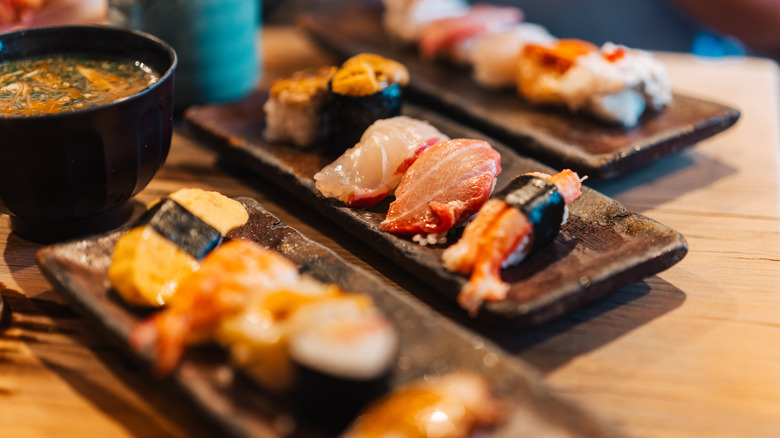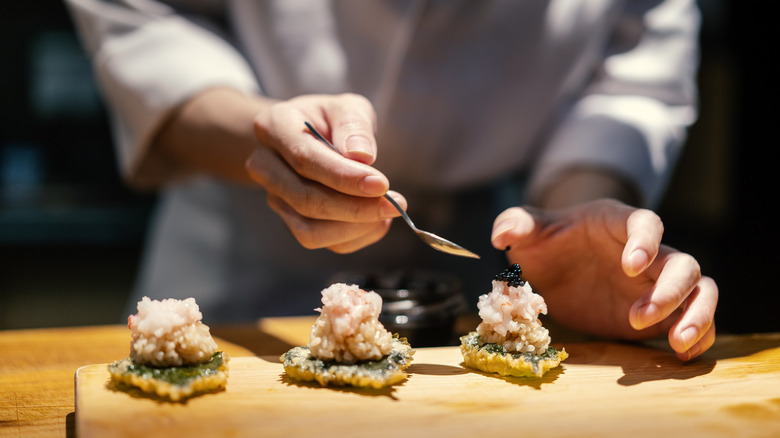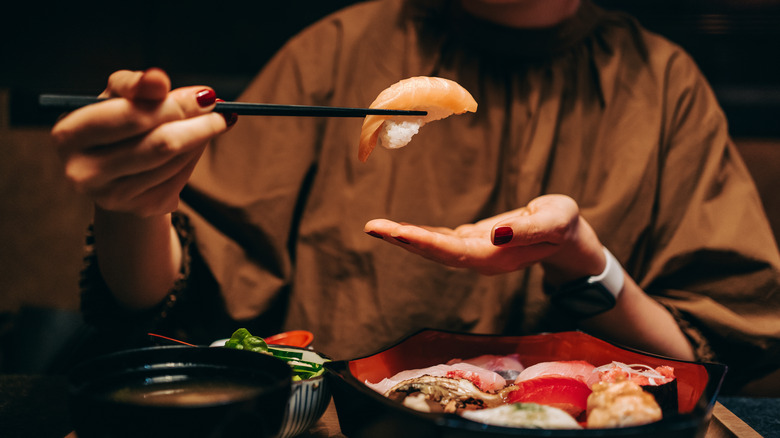8 Red Flags At A Sushi Bar That Should Make You Turn Around, According To A Chef
Dining at a sushi restaurant — especially in the U.S. — can sometimes be more stressful than it needs to be. If you've ever gotten sick from a bad sushi restaurant, you know exactly what we're talking about. You might feel like eating sushi is a gamble every single time you go out, but the truth is, you probably just don't know how to tell a bad sushi restaurant from a good one yet. Once you know how to spot some serious sushi restaurant red flags, you'll feel much more confident that the sushi restaurants you pick will never make you sick.
We love sushi as much as the next person (seriously, who doesn't?), so we spoke to an expert sushi chef who could tell us exactly what sets good sushi restaurants apart from the bad ones. We talked with head sushi chef Akar Win at award-winning group of sushi restaurants, Uchi, to learn more. (Win heads the West Hollywood location.) Uchi is a complete "green flag" of a sushi restaurant by all means, and Win told us absolutely everything you'll need to know in order to figure out whether your local sushi joint is waving green flags or red ones. Here are eight red flags you should look out for before you order a plate of restaurant sushi.
The fish isn't fresh
"Fresh fish has bright colored flesh," says Win. "Browning or discoloration means the fish is not as fresh as it could be." After fish have been cut and prepared, Win explains, they begin to oxidize. This occurs a few hours after the flesh has initially been exposed to air.
Quality fish will be cut to order — or at least not multiple hours ahead of being used for your sushi. The thing about sushi is that the freshness determines the quality 100% of the time. If your sushi doesn't use fresh fish, it won't taste good. That doesn't mean that you can't still enjoy sushi bento boxes — but restaurant-quality sushi should never be relying on fish that has been prepared ahead of time.
If you're in Japan, Win adds, there's one key difference that might indicate a fish is fresh. "Most fishes are served with the blood line in Japan to ensure the quality of the freshness," Win says. This is a visible red line down the back of the cut of fish that indicates it's still fresh. "In the United States, most restaurants remove [the blood line] since the guests do not like the intense flavor of the blood line." So, if you're dining abroad, look for a blood line — if you're sticking to U.S. sushi restaurants, you likely won't find one regardless of whether the fish is fresh.
The restaurant offers these kinds of fish
The number one sushi rule to protect your palette (and your gut)? Don't ever dine at a restaurant whose menu offers the following fish: white fish, white tuna, or seasonal white fish, according to Win. White tuna on most sushi restaurant menus isn't actually white tuna; it's escolar, which has actually been banned in Japan because of the digestive distress it causes when eaten raw. Many people know it for its unfortunate laxative effect.
Even if there isn't a specific problem with the white fish (like the white fish being more likely to contain parasites), it might still be difficult for you to digest raw and could make you feel ill. Because of this, seeing unspecified white fish on a sushi menu is generally a bad sign — most quality sushi restaurants will know better than to serve fish like escolar to their customers. Misnaming fish is also an illegal practice, though it's rarely enforced.
It's important to know that when we say "white fish," we mean that you should look out for a menu that specifically reads "white fish" or "white tuna". Win isn't trying to say that every single white fish makes bad sushi. For example, you'll find grouper — a white fish that makes delicious sushi — on the menu at Uchi West Hollywood. "White fish" is a bad sign when the restaurant doesn't care to specify exactly what type of fish its using ... or if they admit it's escolar when you ask.
The sushi rolls don't specify the fish they use
Would you ever order a dish at a restaurant without knowing what's in it? Surprisingly, a lot of people will when it comes to sushi. Don't assume that you know what's in your sushi roll just because it has a common name — like a California roll or a Philadelphia roll. More specifically, you shouldn't order any sushi that doesn't specify what type of fish is used in it.
"Be very wary if there is a sushi roll with assorted fishes without the names of each type," says Win, "it's most likely using fish trims that are not good enough for nigiri or sashimi." When chefs are proud of the fish they use for their sushi, it's guaranteed to be listed clearly on the menu. You can usually find this information directly under the name of the sushi roll being served. Quality sushi restaurants want you to know exactly what types of fish are being used in each sushi roll — that is their selling point, after all.
This is also a way for sushi restaurants to hide the origin of the fish they're serving or just offer you a random mix of fish that, like Win says, wasn't quality enough to be served on its own. An assortment of fish within a sushi roll can be delicious if they all go together, but not if the restaurant is just filling their sushi rolls with whatever they have on hand.
There's no information on where the fish is sourced from
One major thing that Win points out as a green flag for restaurants is when there is sourcing information provided. "A green light is if a menu contains the origin of the fish or where they were sourced, which shows that the chefs care about quality," says Win. You might find this information at the very bottom of the menu, which will give you general information about where product has been fished or distributed from. You might also find this information in the description of each sushi roll — details like Alaskan snow crab or the origin of wild-caught salmon can give you more information about the kind of fish you're about to order.
Another easy way to determine where the fish came from if it's not on the menu is to ask the staff. It's true that not every single sushi restaurant will list all of their fishes' origins on their menus, so your local restaurant might not be waving red flags just yet if their menu isn't very detailed. But if you ask the staff and you still don't get an answer, you definitely have a problem on your hands.
The staff can't answer your questions
One of the biggest problems, according to Win, is, "a lack of knowledge of the food from the staff, which indicates that the chefs are not well-versed in the food they are making." Win also adds that if the staff aren't able to answer questions about the menu, the restaurant's chefs might not care enough about the menu or the origin of their sushi to give staff a basic rundown.
A quality sushi restaurant will always brief their staff on answering questions about the menu, so feel free to ask away if you want to judge the quality of a new sushi spot. "Confidence when answering questions from a waitstaff or chef is a definite green light."
One thing to note is that Win doesn't think it's a red flag if servers need to double-check information with chefs or another staff member before answering your questions. "Even if they do not have the answers on the spot, if they come back with the answers after asking the other staff, this means they truly care," says Win. So, don't rush out right away if it takes you some time to get your answers back. As long as you feel like the staff satisfies your curiosity once they've figured out the information they need, you're safe to dine.
The restaurant isn't busy
"If a restaurant is busy and hard to get reservations at, that means the restaurant is doing something good ... definite green flag," says Win. "Especially at a sushi restaurant, a busy restaurant means constant fresh fish and ingredients."
You can expect a restaurant to be busiest right around the typical "dinner rush" time (usually 6 to 9 p.m.), especially on the weekends. If you come in at 4 o'clock on a weekday, chances are your local sushi spot won't be super busy regardless — unless it's already extremely difficult to get a table at.
If you're planning on dropping by during off-hours but want to know how busy the restaurant is normally, you can check the reservations page on the restaurant's website. If they have booked tables, you know it's going to be good.
You can also tell how busy a restaurant is by checking reviews online. If they have hundreds or thousands of reviews, that means they see a lot of people on the regular. If they have absolutely no reviews at all, that's a huge red flag. Of course, you can't predict how good a sushi restaurant will be by how crowded it is 100% of the time. But combining this method with a little research into a restaurant's reviews ahead of time will guarantee you find a good sushi spot.
The restaurant has bad reviews or no reviews
As with any restaurant, you can tell a lot about a sushi restaurant based on its reviews. You should always read a sushi restaurant's ratings online before you visit it. "Read online reviews and do research before you go," advises Win. "Look at what most people recommend on the menu."
One or two bad ratings usually doesn't mean anything, but you'll still want to look at exactly what people are saying when they leave their rating. Are there bad reviews because the fish wasn't fresh, or just because someone was upset they couldn't get a table? Did someone think the sushi made them ill, or did they just not like what they ordered? One or two bad reviews saying, for example, the restaurant was busy and hard to get a table at could actually be a green flag in disguise.
You should also be checking out what the high ratings say — what dishes did a diner get and what parts of the experience did they enjoy the most? Doing research ahead of time means you'll know exactly what dishes you should order (and will be prepared if there are any common sushi dishes you shouldn't get). You can also dine with more confidence knowing that a sushi restaurant is safe to eat at, has fresh fish, and is recommended by others.
They have no recommendations for you
We asked Win if there were any questions sushi lovers should ask the waitstaff at a restaurant before dining to check for any additional red flags. His answer was surprising, but it makes a lot of sense. Win says that you should ask the staff for what they would recommend. "When asking these questions, it would be helpful if you let us know your favorite fish or what you usually get when you go to a sushi restaurant, so our recommendation will be relevant to what you will likely eat or enjoy eating," adds Win.
Waitstaff and chefs who know their menu inside and out will be able to provide accurate recommendations for you. They'll want to make your experience special — when a sushi restaurant's staff cares about the quality of their fish and of the food they serve, they want to make sure every guest has a stellar experience. So, asking this question is a win-win for you: You can make sure the restaurant is a good spot to dine at if they have good recommendations for you, and you'll get to order dishes that you know will be exactly to your tastes.
As a bonus, Win also adds that you should always ask the staff how their day is going. "It sounds like a joke," says Win, "but that would make the waitstaff and chef so much willing to make [your] dining experience special."
